4 minute read
Most geospatial brands struggle to differentiate themselves. They focus on their product, their technology, their features.
But the brands that win? They know their customers better than anyone else.
Not just their industry. Not just their job title. Not just their surface-level pain points…
But what drives them—their frustrations, ambitions, pressures, and the real-world stakes of the decisions they make every day.
That level of understanding isn’t a “nice to have.” It’s the most powerful competitive advantage you can build.
Most Geospatial Customer Personas Are Too Shallow

Take a look at your ideal customer persona (ICP). If it’s something like this:
- “GIS Manager at a utilities company”
- “Urban planning lead at a local council”
- “Logistics coordinator at a large enterprise”
That’s not a persona. That’s a job title.
And it won’t get you anywhere close to the messaging that actually moves people.
To create compelling, category-leading marketing, you need to dig deeper.
A GIS Manager at a utilities company isn’t just “looking for better data management.” They might be:
- Drowning in disorganized spatial data but can’t get leadership buy-in for better tools.
- Worried about being blamed for operational failures when outdated data leads to costly mistakes.
- Struggling to prove the ROI of GIS investments to decision-makers who don’t understand its value.
Those aren’t just “pain points.” They’re emotional drivers—fear, frustration, career risk. And that is what your messaging needs to tap into.
Because no one wakes up thinking, “I need a better GIS platform.” They wake up thinking, “I cannot afford another mistake that delays this project and makes me look bad.”
How to Actually Understand Your Audience
Understanding your audience is more than a one-time exercise. It requires ongoing research, customer conversations, and a commitment to real insights.
Here’s where to start:
👉 Talk to Your Customers. Interviews are gold. Ask about their daily struggles, decision-making processes, and what they actually care about.
👉 Analyze Real Data. Look at customer reviews, support tickets, and feedback surveys. What words do they use? What patterns emerge?
👉 Map Their Journey. What obstacles do they face at each stage of the buying process? Where do they get stuck?
👉 Test and Iterate. A/B test messaging, track engagement, and refine your approach. The best insights come from seeing what actually works.
If you’re not doing this, you’re marketing in the dark. And someone who is doing this will win.
How Deep Audience Insights Fuel Better Marketing
Once you understand your audience on a deeper level, everything about your marketing improves.
1. You Create Messaging That Actually Resonates
Most geospatial messaging is too broad, too product-centric, and too vague. If you want to connect with your audience, your messaging needs to shift from:
🚫 “We provide specialist geospatial solutions.”
✅ “Reduce infrastructure downtime by 35% with predictive maintenance powered by real-time GIS analytics.”
Specific. Relevant. Tied to real customer stakes.
2. Your Content Feels Intimate and Personal
Customers don’t want generic blog posts about “the benefits of GIS.” They want insights that directly speak to their reality.
- A disaster response lead doesn’t need an intro to remote sensing. They need a practical breakdown of how satellite analytics improved response times in a real emergency.
- A logistics manager doesn’t care about mapping in general. They care about how spatial data cut route inefficiencies by 22% for a competitor in their space.
When your content is built on deep audience insights, it feels personalized—even when it’s not.
3. You Can Dominate Your Niche and Expand Strategically
Geospatial technology has near-limitless applications. But trying to market to everyone at once leads to diluted messaging and low engagement.
The best brands start narrow, dominate a niche, and then expand strategically.
1️⃣ Find Your Niche – Identify a specific segment or use case where you can create fast wins.
2️⃣ Own That Niche – Build trust, case studies, and demand before expanding.
3️⃣ Scale Intelligently – Use customer success from one market to enter adjacent ones with credibility.
Trying to capture every possible customer at once is a losing strategy. Winning one niche and expanding from there? That’s how industry leaders are made.
The Bottom Line
In geospatial, whoever understands the customer best wins.
Most brands get lazy. They settle for basic personas, generic messaging, and one-size-fits-all content.
The companies that dominate the market? They do the work. They dig deeper. They understand the real struggles, stakes, and motivations of their audience.
And because of that, they win their audience’s heads and hearts.
Want that brand to be yours? 👉 Let’s chat.
